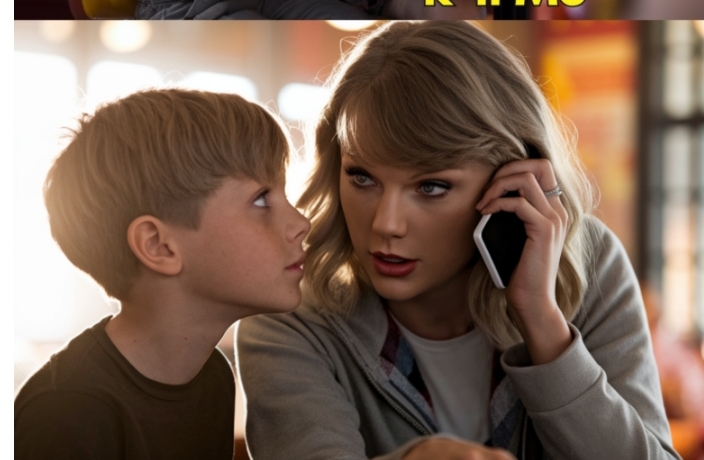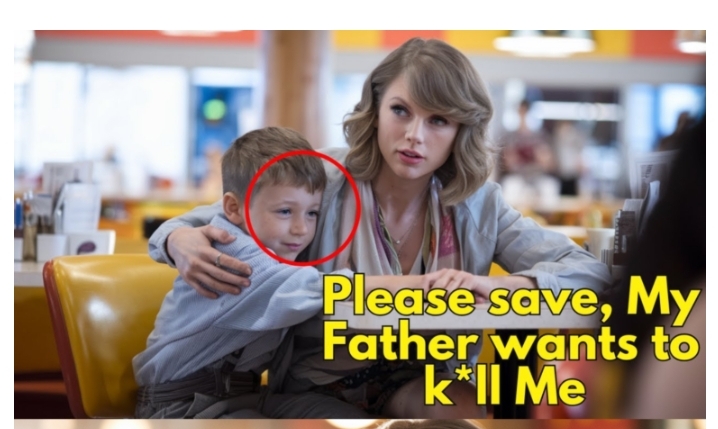CELEBRITY
Just in: 5-Year-Old Boy Whispers to Taylor Swift in McDonald’s – She Turns Pale & Quickly Calls 911…

Just in: 5-Year-Old Boy Whispers to Taylor Swift in McDonald’s – She Turns Pale & Quickly Calls 911…Read more
/
In early 2025, a sensational story swept across social media and tabloid headlines: a 5-year-old boy allegedly whispered something to pop superstar Taylor Swift in a McDonald’s, causing her to turn pale and immediately call 911. The narrative, with its blend of intrigue, celebrity allure, and a child’s mysterious words, captured the internet’s imagination. But as with many viral tales, the line between fact and fiction blurred quickly. This article dives into the origins of the story, its cultural impact, the psychology behind its virality, and why such narratives resonate so deeply in today’s digital age.
The Story’s Emergence
The tale first gained traction on platforms like YouTube and TikTok, where clickbait-style videos and posts teased dramatic reenactments or speculative commentary. The premise was simple yet gripping: during a rare, casual outing to a McDonald’s, Taylor Swift, a global icon known for her carefully curated public image, encountered a young boy. His whispered words—never explicitly revealed in most versions—were so shocking that Swift, visibly shaken, dialed emergency services. The lack of concrete details only fueled speculation, with theories ranging from the boy revealing a personal secret to warning of imminent danger.
No credible news outlet reported the incident, and Swift’s team remained silent, which is typical for unverified rumors. Yet, the story’s vagueness allowed it to morph into countless variations. Some claimed the boy was a fan who recognized Swift despite her attempts at anonymity; others spun darker tales of supernatural or conspiratorial undertones. The absence of evidence didn’t deter its spread—instead, it became a blank canvas for public imagination.
Similar Stories and a Pattern
The Swift-McDonald’s tale wasn’t entirely unique. In recent months, similar stories surfaced involving other celebrities like Keanu Reeves, Clint Eastwood, and Shaquille O’Neal. Each followed a near-identical formula: a young child whispers something alarming in a public setting (often a diner or fast-food restaurant), prompting the star to call 911. These narratives, often hosted on YouTube channels specializing in “heartwarming” or “shocking” stories, racked up millions of views. For instance, a January 2025 video titled “5-Year-Old Boy Whispers to Keanu Reeves in McDonalds – He Turns Pale & Quickly Calls 911” garnered significant attention, despite lacking any verifiable basis.
This pattern suggests a deliberate trend in content creation. Storytellers—whether independent creators or algorithm-driven media—capitalize on the emotional pull of celebrities interacting with ordinary people, especially children. The fast-food setting adds relatability, grounding fantastical plots in familiar environments. McDonald’s, with its universal presence, serves as a perfect backdrop for such tales, evoking nostalgia and accessibility.
Why This Story Resonated
The story’s virality can be attributed to several psychological and cultural factors:
Celebrity Fascination: Taylor Swift is more than a musician—she’s a cultural phenomenon. Her fans, known as Swifties, dissect every detail of her life, from lyrics to public appearances. A story placing her in an unguarded moment taps into the public’s desire to see celebrities as “human,” vulnerable to the same surprises as anyone else.
 0
0
The Power of Mystery: The undefined nature of the boy’s whisper invited speculation. Was it a threat? A revelation about Swift’s personal life? A prophetic warning? Humans are wired to fill in narrative gaps, and the story’s ambiguity made it a perfect vessel for projection. Social media threads buzzed with theories, each more creative than the last.
Emotional Stakes: A child as the catalyst heightened the drama. Children symbolize innocence and truth, making their words carry weight in storytelling. The image of a 5-year-old unsettling a poised superstar creates an emotional contrast that’s hard to resist.
Fast-Food Relatability: McDonald’s is a global touchstone. The idea of a megastar like Swift grabbing a burger makes her seem approachable, while the absurdity of a 911 call in such a mundane setting adds intrigue. It’s a collision of the ordinary and extraordinary.
Digital Amplification: Platforms like TikTok and YouTube thrive on shareable, emotionally charged content. Algorithms prioritize engagement, so sensational titles like “She Turns Pale & Quickly Calls 911” are designed to hook viewers. Once shared, these stories snowball, fueled by likes, comments, and retweets.
Fact-Checking the Fiction
Despite its grip on public attention, no evidence supports the Swift-McDonald’s story. Here’s why it’s almost certainly fabricated:
Lack of Primary Sources: No police reports, eyewitness accounts, or local news stories corroborate the incident. Major events involving celebrities typically leave a digital footprint, yet this one exists only in viral videos and posts.
Swift’s Public Life: Taylor Swift rarely appears in public without security, especially in casual settings like fast-food restaurants. Her movements are heavily scrutinized, making an unnoticed McDonald’s visit unlikely.
Recycled Tropes: The story mirrors other celebrity-driven clickbait, suggesting it’s part of a content farm strategy. Channels repurpose the same narrative structure, swapping names to maximize views.
Silence from Swift: Swift and her team are adept at addressing rumors when necessary. Their silence here implies the story doesn’t warrant a response, likely because it’s baseless.
The Ethics of Clickbait Storytelling
The Swift-McDonald’s saga raises questions about the ethics of viral content. While harmless on the surface, such stories can mislead audiences, erode trust in media, and exploit celebrities’ images for profit. Content creators often prioritize views over veracity, knowing that emotional hooks—like a child’s whisper or a star’s panic—guarantee clicks. This cycle feeds a culture of misinformation, where fiction can spread faster than fact.
On the flip side, these stories serve as modern-day folklore, filling a human need for shared narratives. They’re not malicious in intent; they’re entertainment, crafted to captivate. The problem arises when audiences take them at face value, blurring the line between harmless fun and harmful distortion.
Cultural Reflections
The story’s popularity reflects broader societal trends. In an era of information overload, people crave simple, emotionally resonant tales. A celebrity in distress, a child’s cryptic message—these are archetypes that echo ancient myths, repackaged for the digital age. The McDonald’s setting adds a layer of Americana, tying into nostalgia for simpler times when fast food was a treat and celebrities seemed less distant.
Moreover, the story taps into fascination with Swift’s persona. Known for her storytelling through music, she’s a figure fans feel they “know,” even if her private life remains guarded. A fictional encounter with a truth-telling child plays into fantasies of piercing that veil, revealing the “real” Taylor.
Conclusion
The tale of the 5-year-old boy whispering to Taylor Swift in a McDonald’s is a quintessential internet phenomenon—captivating, unverifiable, and endlessly adaptable. It’s less about truth and more about what it reveals: our love for drama, our obsession with celebrities, and our need for stories that spark wonder. While the incident almost certainly never happened, its cultural footprint is real, reminding us how easily a whisper can become a roar in the digital echo chamber.
As the internet churns out new variations—perhaps with different stars or settings—the core appeal remains. We’re drawn to the unknown, the emotional, the human. And in that sense, the story’s true power lies not in what the boy said, but in why we keep listening.























